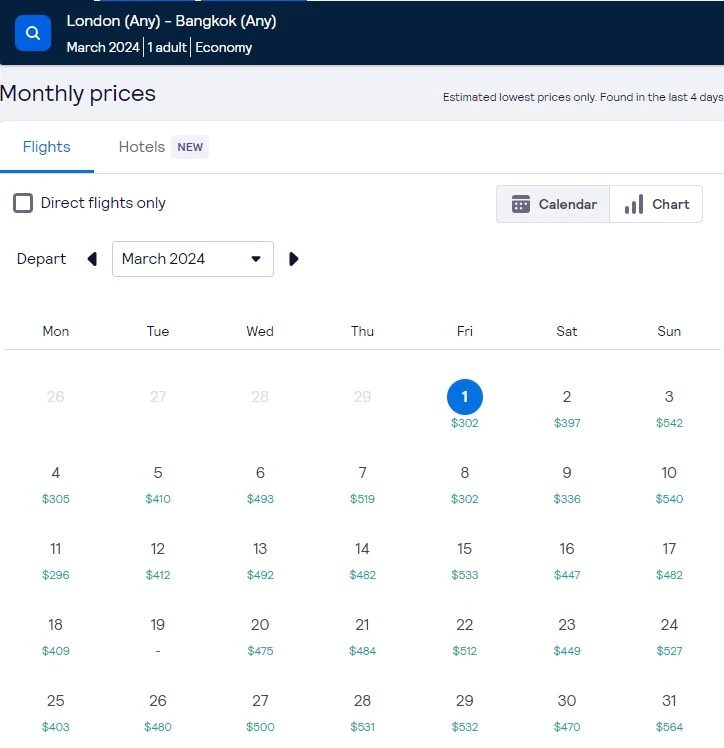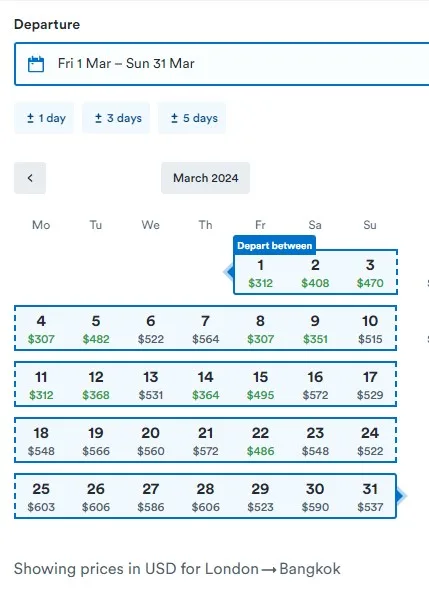Finding cheap flights is tough. They’re often the most expensive part of your trip. What’s more, searching the vast depths of the internet for a deal can be tiresome and frustrating.
Fortunately, there are a few tips that you can use to ensure you don’t miss out.
In this article, I’ll show you exactly how to find cheap airfares, so you never need to overpay again.
I’ve traveled extensively, and have been using these exact steps to find the cheapest possible flights since I started back in 2009.
Gone are the days when travel agents would find you the best deals on airfares. You can now easily find these yourself as you plan your trip! This step-by-step guide will walk you through the process and give you the only tips you need to find cheap flights.

Affiliate Disclosure: Thank you for supporting The Road Trip Expert. When you purchase through links on this site, we may earn an affiliate commission. Please see our advertising disclosure for more details.
Ignore Common Myths
Before we get into the good stuff, let’s bust some common myths about booking cheap airfares.
Myth 1: Booking flights on a specific day of the week guarantees lower prices.
Reality: While some studies have suggested that certain days might have marginally lower fares, there’s no universally optimal day to book flights. Airline pricing algorithms are complex and frequently updated, so it’s more important to focus on other factors, such as flexibility with travel dates and booking in advance.
Myth 2: Last-minute bookings always result in cheap deals.
Reality: While last-minute deals can occasionally be found, they’re not a reliable strategy for securing cheap flights. Airlines often increase prices as the departure date approaches, so it’s generally better to book well in advance.
A good way to take advantage of the last-minute deals that do arise is to sign up for flight alerts from Going (Formerly Scotts Cheap Flights)
Myth 3: Round-trip tickets are always cheaper than two one-way tickets.
Reality: This isn’t always the case. Sometimes, booking two one-way tickets with different airlines or booking websites can result in a lower total cost than purchasing a round-trip ticket. It’s a good idea to compare both options before making a decision.
Myth 4: Incognito mode guarantees lower prices.
Reality: Using incognito mode can prevent websites from tracking your search history and using cookies to tailor prices based on your behavior. However, there’s no concrete evidence that using incognito mode consistently results in lower prices.
Myth 5: Low-cost carriers always offer the cheapest flights.
Reality: While low-cost carriers often have lower base fares, they also tend to charge additional fees for baggage, seat selection, and other services. When comparing prices, it’s essential to consider the total cost of the trip, including any additional fees, to determine the best deal.
With those out of the way, let’s get into some tips for finding cheap flights that will actually save you money.
Search multiple booking websites and use fare aggregators
Use various search engines and online travel agencies (OTAs) to compare prices. Some sites may have exclusive deals or promotional offers.
Websites like Google Flights, Skyscanner, or Kiwi compile fares from multiple airlines and OTAs, making it easier to find the best deals.
There are several airline search engines out there, all of which have different and useful features. That being said, below are my preferred sites for finding cheap flights. They seem to consistently produce the best results.
- Skyscanner – A broad comparison site that lets you search with flexible travel dates.
- Kiwi.com – Combines all airlines to create routes that are cheaper than booking with just 1 airline.
- Google Flights – Has an excellent map view for a flexible destination search.
Not all airlines are listed on fare aggregators so it’s important to research any additional airlines that fly the intended route.
Being flexible is what saves you the most money
Now that you have a few options for searching it’s time to start comparing prices. The best way to save money on flights is by being as flexible as possible. Here is a list of ways you can be flexible and you can use the above fare aggregators to compare prices.
- Be flexible when you fly (day, date, time of day) – Prices can vary significantly depending on the day, date, or time of your flight. Try adjusting your travel dates to find better deals.
- Be flexible about which airport you fly to – If you’re flying to or from a city with multiple airports, compare prices for each. It might be cheaper to fly to a less popular airport and then travel to your final destination by train or bus. (Skyscanner allows you to easily add nearby airports to your searches). Make sure you account for additional costs to get to your final destination.
- Consider taking indirect flights with one or more stops – While it might not be the quickest or most eco-friendly option, it’s sometimes cheaper to take a flight somewhere else and then a second flight from there to your final destination. Direct flights are usually more expensive than flights with layovers. Ensure you have sufficient time to make your connection.
- Consider a multi-day layover – Use Airwander to find flight itineraries that include multi-day stopovers in “bonus cities”. You can select the number of days you’d like to stopover to be and choose from suggested “bonus cities”. This can result in a cheaper itinerary and an additional place to visit! Don’t forget you might need a visa for your stopover.
- Be flexible about when you make a booking (to take advantage of deals) – Sign up for price alerts from Going (Formerly Scotts Cheap Flights) to get last-minute deals.
- Be flexible about what airline(s) you fly with – Not all budget airlines are included in the results from the above-listed fare aggregators. Make sure you check for additional flight options. Always calculate the total cost for comparison as it’s common for budget airlines to charge for add-ons (baggage, etc.).
- Be flexible about what currency you pay in – Check if it’s cheaper to pay in different currencies. Full section on this below
Search for one-way tickets first followed by return tickets
Skyscanner, Google Flights, and Kiwi all allow you to easily search for the best price within a given month for a one-way ticket. You should first identify the best price you can get by booking two one-way tickets separately.
By searching for one-way tickets, you will have identified the cheapest departure dates to your destination. Use this information to then alter the settings on the fare aggregator to check for return ticket prices departing on those dates.
You are now able to compare the best prices for return tickets and the best prices for two separate bookings of one-way tickets.
Remember to add nearby airports, consider indirect flights, and potentially take a multi-day stopover. Take into account additional costs that will be incurred by not flying to your first choice airport.
Here is a side-by-side comparison of the grid format price output from Kiwi and Skyscanner.


Understand the risks of booking indirect flights with different airlines
Booking a flight itinerary with one or more stops using separate tickets from different airlines can be an enticing option for travelers looking to save money. However, this approach comes with its own set of risks. When booking separate tickets, you may face issues such as tight layover times, making it difficult to navigate between terminals and clear security checks.
Additionally, should one of your flights be delayed or canceled, the other airline may not be obligated to accommodate you on a later flight, potentially leaving you stranded and incurring additional costs. Furthermore, luggage transfers between separate tickets are often not guaranteed, which may require you to collect and re-check your bags at each layover.
Some booking providers, such as Kiwi.com, do offer a level of protection for separate tickets booked together, but it’s essential to conduct thorough research and fully understand the potential risks before making such a booking.
Set up fare alerts if you don’t want to book immediately
Many travel websites offer to notify you when prices drop for your desired route. Sign up for fare alerts to stay informed about the best deals.
Fare aggregators often use historic price data to show you how close the current price is to the typical price for that route. This can help you understand if you’re paying a normal fare.
Sign up for mailing deals and special offers
Sign up for mailing lists to get deals and last-minute specials. Airlines occasionally have flash sales where cheap fares are only available for a short period. By signing up for mailing lists, you ensure you don’t miss out.
Here are some mailing lists that I recommend joining:
- Going (Formerly Scott’s Cheap Flights) – Great for US flight deals
- Airfarewatchdog – Lists error and sale fares
- The Flight Deal – Great for flight deals all over the globe
- Jacks Flight Club – Perfect for inspiration and cheap flight deals for those flexible on destination
Check if you’re eligible for discounts
Some airlines offer discounted fares for students, military personnel, or other specific groups. Check if you’re eligible for any special discounts before booking.
- StudentUniverse is a travel agency specializing in getting the best deals for students.
- Upgraded Points has a useful guide to help military personnel find a full list of military discounts on flights.
Join airline rewards programs
Airline reward programs, also known as frequent flyer programs, are loyalty schemes designed by airlines to incentivize and reward repeat customers. By enrolling in these programs, travelers earn points or miles each time they fly with the airline or its partner carriers, as well as through affiliated credit cards, hotels, car rentals, and other partners.
The accumulation of points or miles can be redeemed for cheaper airfares, seat upgrades, or even free flights, making it an attractive option for frequent travelers. Some programs also feature tiered membership levels, where passengers who reach a certain threshold of points or miles within a given period are granted elite status. Elite status often comes with additional perks, such as priority check-in, increased baggage allowance, lounge access, and priority boarding.
By strategically utilizing airline reward programs, frequent travelers can not only save on airfare but also enjoy an enhanced travel experience with various exclusive benefits.
Check out this article if you’re looking to compare airline reward programs.
If you’re in a group consider booking separately
When booking flights for a group, it depends on the situation whether it’s better to book individually or as a group. Here are some factors to consider:
- Group discounts: Some airlines offer group discounts when you book a certain number of tickets together. In such cases, it might be more cost-effective to book as a group.
- Fare Availability: Airlines have a limited number of seats at each price tier. If you book 4 tickets together, the booking system will look for 4 seats at the same fare. If there are only 2 or 3 seats available at a lower fare, the system will default to a higher fare for all 4 tickets. Booking individually might help you secure some seats at a lower fare, but there’s no guarantee that all 4 passengers will get the same price.
- Seat Allocation: Booking as a group often makes it easier to ensure that everyone sits together. If that’s important to you, it might be worth booking as a group even if it means paying a slightly higher fare.
- Convenience: Booking individually can be more time-consuming, as you’ll need to complete the booking process multiple times. However, it might be worth the effort if it results in significant savings.
In summary, it’s essential to weigh the potential savings against the convenience and seat allocation when deciding whether to book individually or as a group. Always compare prices for both options before making your decision.
It pays to be smart when finding cheap flights.
Check the price in other currencies and consider fees
Budget airlines tend to charge you in the currency of your departure country, but you can sometimes change this. Do a quick check to see if the ticket is cheaper in your home currency or the local one. Sometimes this won’t make a difference, but depending on how the 2 currencies have been doing in the market, there is sometimes a significant difference.
The currency you pay in can make a difference when booking flights due to exchange rates and potential fees. Here’s how it can affect your purchase:
- Exchange rates: If you book a flight in a different currency, the final cost in your local currency may vary depending on the current exchange rate. Sometimes, booking in a weaker currency can result in lower costs due to favorable exchange rates.
- Foreign transaction fees: When using a credit card to pay in a foreign currency, some banks charge foreign transaction fees. These fees can range from 1% to 3% of the transaction amount. To avoid such fees, consider using a credit card with no foreign transaction fees or paying in your local currency.
- Dynamic currency conversion (DCC): Some booking websites or airlines may offer to convert the purchase price to your local currency at checkout. While this may seem convenient, the exchange rate used for DCC is often unfavorable when compared to the rate your bank would apply. It’s usually better to pay in the local currency of the airline or booking website and let your bank handle the conversion.
To find potential savings, try searching for flights on websites based in different countries or those that allow you to switch currencies. Compare the prices and consider the exchange rate and any fees before making a decision. However, keep in mind that savings may be marginal, and it’s essential to weigh the potential benefits against the time and effort involved in searching for the best currency to pay in.
If you pay in another currency, use a credit card that has no/low foreign transaction fees! We’ve recommended some good travel money cards on our Resources page. I personally take a WISE card when I go abroad.

Booking early is usually better
In my experience, airline tickets very rarely get cheaper as you get closer to your departure date. This is especially true if you have a set travel date in mind. Fares often increase as the departure date approaches. Booking your flight several months in advance can help you secure a lower price.
As such, if you know when you want to fly, don’t wait. The earlier you book, the more money you will likely save.
Don’t wait too long for flights to get cheaper
It’s very rare. When you know where you want to go and have found a cheap flight, book it and move on. Don’t obsess or wait; it’s more than likely you’ll end up overpaying.
So there you have it. Awesome ways to find cheap flights. Now it’s your turn.
Which tip are you going to try first?
Do you have any more helpful tips for finding cheap flight tickets?
Either way, leave a comment below and let us know!
Whilst you’re here…
We have some new Travel Tips articles you might be interested in including an awesome article on planning a trip. Feel free to check them out!
Disclosure: Some of the links in this article may be affiliate links. This means I earn a commission if you make a qualifying purchase, but this is at no additional cost to you. Thank you for supporting The Road Trip Expert.




